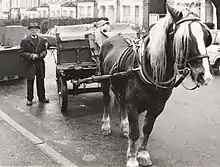Rag-and-bone man
A rag-and-bone man or ragpicker[2] (UK English) or ragman,[3] old-clothesman,[4] junkman, or junk dealer[5] (US English), also called a bone-grubber, bone-picker, rag-gatherer, bag board, or totter,[6][7] collects unwanted household items and sells them to merchants. Traditionally this was a task performed on foot, with the scavenged materials (which included rags, bones and various metals) kept in a small bag slung over the shoulder. Some rag-and-bone men used a cart, sometimes pulled by a horse or pony.

In the 19th century, rag-and-bone men typically lived in extreme poverty, surviving on the proceeds of what they collected each day. Conditions improved following the Second World War, but the trade declined during the latter half of the 20th century. However, in more recent years, partly as the result of the soaring price of scrap metal, rag-and-bone men may once again be seen at work in many Third World (as well as some First World) countries.
19th century

In the UK, 19th-century rag-and-bone men scavenged unwanted rags, bones, metal and other waste from the towns and cities in which they lived.[8] Henry Mayhew's 1851 report London Labour and the London Poor estimates that in London, between 800 and 1,000 "bone-grubbers and rag-gatherers" lived in lodging houses, garrets and "ill-furnished rooms in the lowest neighbourhoods."[9]
The bone-picker and rag-gatherer may be known at once by the greasy bag which he carries on his back. Usually he has a stick in his hand, and this is armed with a spike or hook, for the purpose of more easily turning over the heaps of ashes or dirt that are thrown out of the houses, and discovering whether they contain anything that is saleable at the rag-and-bottle or marine-store shop.
— Henry Mayhew[10]
These bone-grubbers, as they were sometimes known, would typically spend nine or ten hours searching the streets of London for anything of value, before returning to their lodgings to sort whatever they had found.[10] In rural areas where no rag merchants were present, rag-and-bone men often dealt directly with rag paper makers,[11] but in London they sold rag to the local traders. White rag could fetch two to three pence per pound, depending on condition (all rag had to be dry before it could be sold). Coloured rag was worth about two pence per pound. Bones, worth about the same,[10] could be used as knife handles, toys and ornaments, and, when treated, for chemistry. The grease extracted from them was also useful for soapmaking. Metal was more valuable; an 1836 edition of Chambers's Edinburgh Journal describes how "street-grubber[s]" could be seen scraping away the dirt between the paving stones of non-macadamised roads, searching for horseshoe nails.[12] Brass, copper and pewter were valued at about four to five pence per pound. In a typical day, a rag-and-bone man might expect to earn about sixpence.[10]
Mayhew's report indicates that many who worked as rag-and-bone men did so after falling on hard times, and generally lived in squalor.[10] Although they usually started work well before dawn, they were not immune to the public's ire; in 1872, several rag-and-bone men in Westminster caused complaint when they emptied the contents of two dust trucks to search for rags, bones and paper, blocking people's path.[13]
In Paris, ragpickers were regulated by law and could operate only at night. They were required to return unusually valuable items either to the items' owners or to the authorities.[14] When Eugène Poubelle introduced the garbage can in 1884, he was criticised by French newspapers for meddling with the ragpickers' livelihood.[15]
20th century

A 1954 report in The Manchester Guardian mentioned that some men could make as much as £25 a day collecting rags. Most used handcarts rather than a bag, and some used a pony and cart, giving out rubbing stones[nb 1] in exchange for the items that they collected.[17] In 1958, a Manchester Guardian reporter accompanied rag-and-bone man John Bibby as he made his rounds through Chorlton and Stretford, near Manchester. For his handcart's load, which comprised rags, furs, shoes, scrap car parts, a settee and other furniture, Bibby made about £2.[18]
The rag-and-bone trade fell into decline; in the 1950s, Manchester and Salford had, between them, around 60 rag merchants, but this had fallen to about 12 by 1978, many having moved into the scrap-metal trade. Local merchants blamed several factors, including demographic changes, for the decline of their industry.[19]
A 1965 newspaper report estimated that in London, only a "few hundred" rag-and-bone men remained, possibly because of competition from more specialised trades, such as corporation dustmen, and pressure from property developers to build on rag merchants' premises.[20]
In the 1980s, Hollywood star Kirk Douglas mentioned in an interview with Johnny Carson that his father was a ragman in New York and "young people nowadays don't know what is ragman."[21]
Despite the popularity of the BBC's popular television comedy Steptoe and Son, which helped maintain the rag-and-bone man's status in British folklore, by the 1980s they were mostly gone. In more recent years, rising scrap metal prices have prompted their return, although most drive vans rather than horses and carts, and they announce their presence by megaphone, causing some members of the public to complain about the noise they create.[22][23]
See also
- Zabbaleen, a group of people in Egypt who operate in a similar manner
- Junk man
- Glossary of textile manufacturing
- Karung guni, a counterpart to the rag-and-bone man in the former Crown Colony of Singapore.
- Ragpicker, a similar role
References
Footnotes
- It had long been customary for rag-and-bone men to "purchase" items from children with a small gift, but the Public Health Act 1936 stated that, as a defence against the spread of disease, rag-and-bone men could not give children under 14 "any article whatsoever". Goldfish, popular items for trade, were later declared not to be articles.[16]
Notes
- Mayhew 1851, p. 141
- Regulating the Rag and Bone Man, Law Librarians of Congress
- Kuper, Jeremy (5 August 2006), Final collection, Guardian Newspapers Limited
- Mayhew 1851, p. 136, 139
- Mayhew 1851, p. 138
- Mayhew 1851, p. 139
- Magee 2002, pp. 107–108
- Chambers & Chambers 1836, p. 213
- Magee 2002, p. 107
- Edwards 1893, pp. 360–365
- Lynch 1901, pp. 278–279
- Gluckman 2004, pp. 202–203
- "The Rag-And-Bone Collector", The Manchester Guardian (1901–1959), Guardian Newspapers Limited, p. 3, 5 August 1954, ProQuest 479599435
- "A Day in the Life of the Rag-And-Bone Man: Plenty of Muck, but Little Money", The Manchester Guardian (1901–1959), Guardian Newspapers Limited, p. 5, 2 June 1958, ProQuest 480247834
- Finnigan, Roger (17 July 1978), "The Rag End Trade", The Guardian (1959–2003), Guardian Newspapers Limited, p. 12, ProQuest 185958597
- "Squeezing Out the Rag Men", The Times, p. 23, 9 March 1965
- JOHNNY CARSON INTERVIEW KIRK DOUGLAS, Youtube, 5 August 2006
- Edwards, Adam (30 July 2011), Any Old Iron?, The Express, hosted at infoweb.newsbank.com, retrieved 5 December 2011
- Rag and Bone men told to scrap their loudspeakers, The Daily Telegraph, hosted at infoweb.newsbank.com, 27 October 2011, retrieved 5 December 2011
Bibliography
- Chambers, William; Chambers, Robert (1836), Chambers's Edinburgh Journal, IV, Orr and Smith
- Edwards, Henry Sutherland (1893), Old and New Paris: Its history, its people, and its places, Cassell and Co.
- Gluckman, Max (2004), Order and Rebellion in Tribal Africa, Routledge, ISBN 978-0-415-32983-5
- Lynch, Hannah (1901), French Life in Town and Country, Putnam
- Magee, Gary Bryan (2002), Productivity and Performance in the Paper Industry, Cambridge University Press, ISBN 978-0-521-89217-9
- Mayhew, Henry (1851), London Labour and the London Poor, S.N.
Further reading
- For a description of 19th-century French ragmen, or chiffonniers, see Chambers, William; Chambers, Robert (1860). "Chambers's Journal". 33–34. W & R Chambers: 53–55. OCLC 846681048. Cite journal requires
|journal=(help)
External links
| Wikimedia Commons has media related to Rag-and-bone men. |
- The end of the road for the rag-and-bone man, at independent.co.uk
